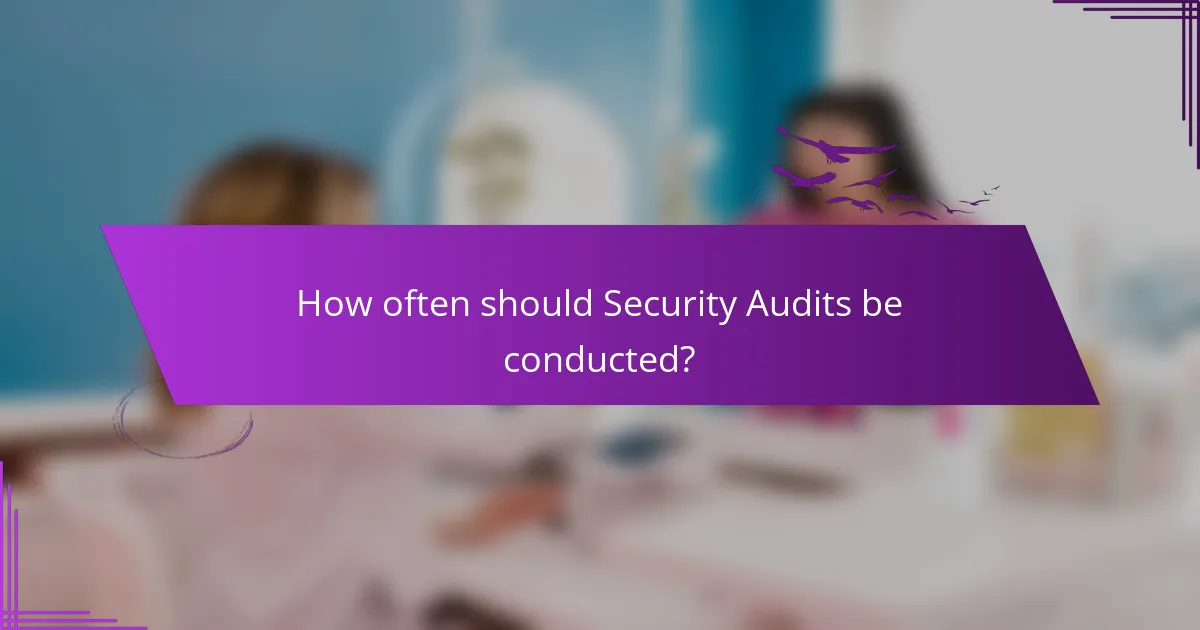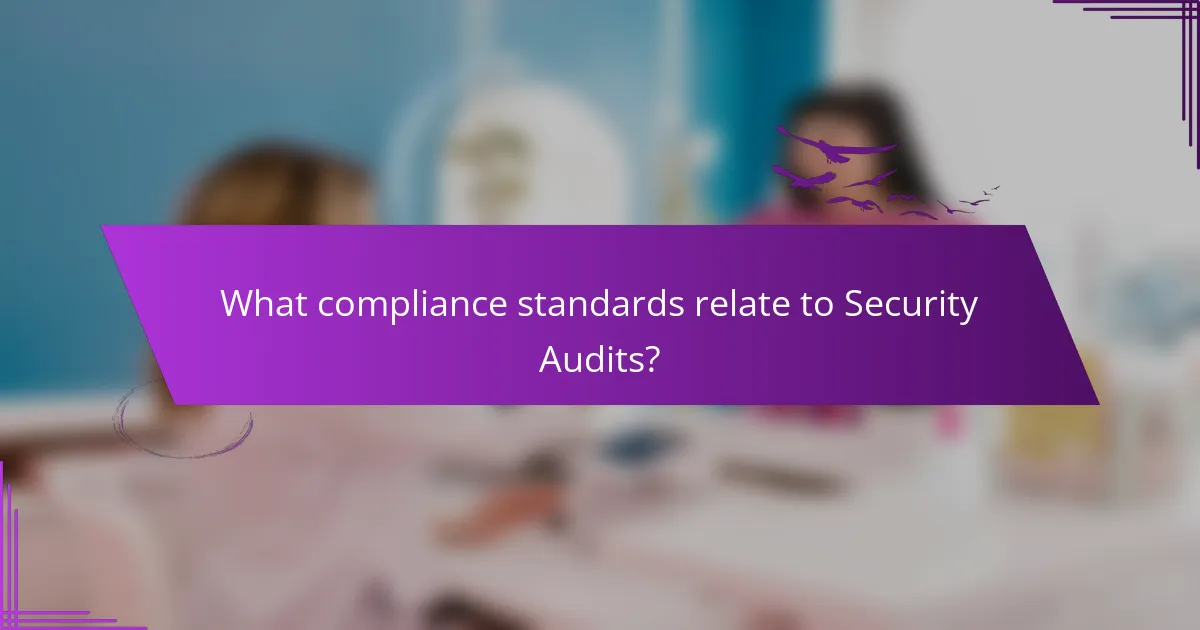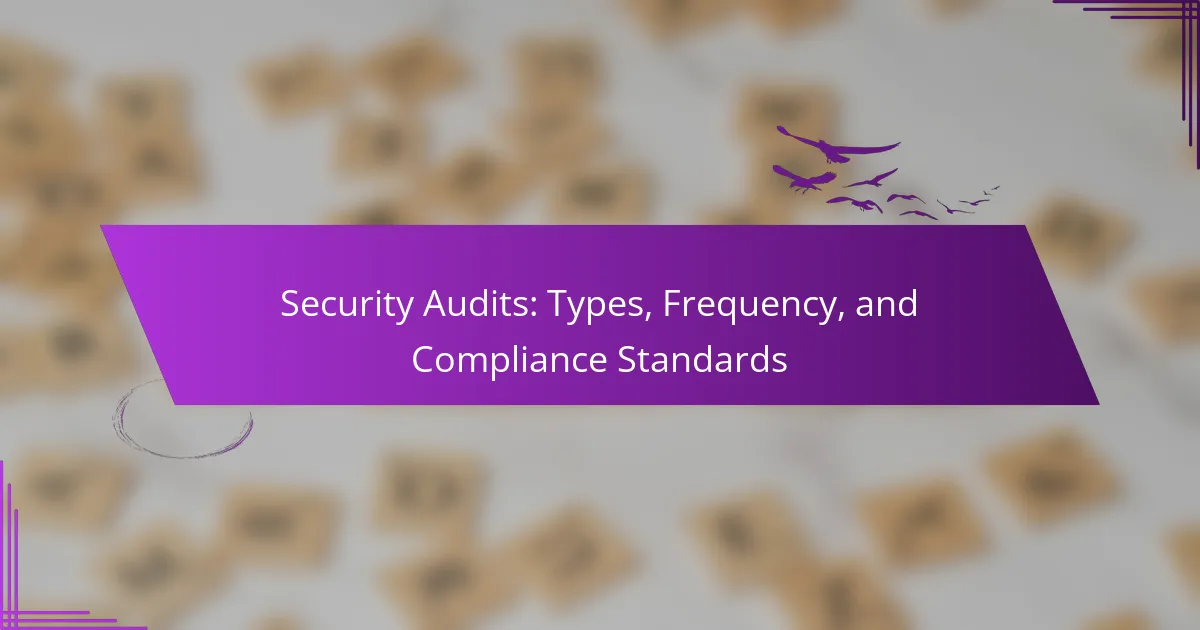
What are Security Audits?
Security audits are systematic evaluations of an organization’s information systems and security policies. They assess the effectiveness of security measures in place. These audits identify vulnerabilities and ensure compliance with relevant regulations. Security audits can be internal or external, depending on the organization’s needs. They often involve reviewing documentation, conducting interviews, and performing technical assessments. The results of a security audit help organizations improve their security posture. Regular audits are essential for maintaining security standards and addressing emerging threats.
Why are Security Audits important?
Security audits are important because they identify vulnerabilities and ensure compliance with regulations. They help organizations assess their security posture and protect sensitive data. Regular audits can reveal weaknesses that may be exploited by cyber threats. According to a report by the Ponemon Institute, organizations that conduct regular security audits reduce the risk of data breaches by 30%. Furthermore, security audits provide a framework for continuous improvement in security practices. This proactive approach minimizes potential losses and enhances overall trust in the organization’s security measures.
What risks do Security Audits help mitigate?
Security audits help mitigate risks related to data breaches, compliance violations, and system vulnerabilities. They identify weaknesses in security controls and provide recommendations for improvement. Regular audits can uncover unauthorized access and insider threats. They also help ensure adherence to regulatory requirements, reducing the risk of fines. By addressing vulnerabilities, audits minimize the likelihood of financial loss due to cyber incidents. Overall, security audits enhance organizational resilience against evolving threats.
How do Security Audits enhance organizational security?
Security audits enhance organizational security by identifying vulnerabilities and weaknesses in systems. They evaluate security policies and practices against established standards. Regular audits help ensure compliance with regulations, reducing the risk of legal penalties. By uncovering potential threats, organizations can implement necessary improvements. Studies show that organizations conducting regular audits experience fewer security incidents. For example, a 2020 report by the Ponemon Institute found that companies with frequent audits reduced their breach costs by 30%. This proactive approach fosters a culture of security awareness among employees. Overall, security audits are essential for maintaining robust security postures.
What types of Security Audits exist?
There are several types of security audits. Common types include compliance audits, which ensure adherence to regulations. Vulnerability assessments identify weaknesses in systems. [censured] testing simulates attacks to evaluate security defenses. Risk assessments analyze potential threats and their impact. IT audits review information technology systems for security and efficiency. Each type serves a distinct purpose in enhancing organizational security.
What is the difference between internal and external Security Audits?
Internal security audits are conducted by an organization’s own staff, while external security audits are performed by independent third-party auditors. Internal audits focus on assessing the effectiveness of internal controls and compliance with policies. They provide insights into operational efficiencies and areas for improvement. External audits, on the other hand, offer an unbiased evaluation of the organization’s security posture. They help ensure compliance with regulatory requirements and industry standards. Internal audits may lack objectivity due to familiarity with the processes. External audits provide a fresh perspective and can identify risks that internal teams may overlook. Both types of audits are essential for comprehensive security management.
How do compliance audits differ from security audits?
Compliance audits assess adherence to specific regulations and standards. They focus on legal requirements and organizational policies. Security audits evaluate the effectiveness of security controls and risk management practices. They analyze vulnerabilities and potential threats to information systems. Compliance audits often involve external regulations, such as HIPAA or GDPR. Security audits are more focused on internal security measures. Compliance audits may result in penalties for non-compliance. Security audits aim to enhance overall security posture.
What are the characteristics of vulnerability assessments?
Vulnerability assessments identify and evaluate security weaknesses in systems. They provide a systematic approach to discovering vulnerabilities. This process typically includes asset identification, threat analysis, and risk evaluation. Vulnerability assessments can be automated or manual, depending on the tools used. They prioritize vulnerabilities based on severity and potential impact. Regular assessments help organizations stay compliant with security standards. The results guide remediation efforts to enhance security posture. Effective vulnerability assessments improve overall risk management strategies.

How often should Security Audits be conducted?
Security audits should be conducted at least annually. This frequency helps organizations identify vulnerabilities and ensure compliance with regulations. Many experts recommend quarterly audits for high-risk environments. Regular audits can adapt to changes in technology and threats. The National Institute of Standards and Technology (NIST) supports regular reviews to maintain security integrity. Conducting audits more frequently can enhance an organization’s security posture.
What factors influence the frequency of Security Audits?
The frequency of security audits is influenced by several key factors. Regulatory requirements often dictate how often audits must occur. Organizations in highly regulated industries may face mandatory audit schedules. Risk assessments also play a significant role in determining audit frequency. Higher risk environments typically require more frequent audits. Additionally, changes in technology can prompt more regular audits. New systems or updates may introduce vulnerabilities that need to be addressed. The size and complexity of the organization can also affect audit frequency. Larger organizations may require more frequent audits due to their diverse operations. Lastly, past audit findings can influence future audit schedules. If previous audits reveal significant issues, more frequent follow-ups may be necessary.
How do industry standards dictate audit frequency?
Industry standards dictate audit frequency by establishing specific guidelines and requirements for organizations. These standards vary by sector and may include regulations from bodies such as ISO, NIST, or PCI DSS. For example, ISO 27001 recommends annual audits to assess the effectiveness of information security management systems. Similarly, PCI DSS mandates quarterly assessments for compliance. These requirements ensure that organizations regularly evaluate their security practices. Compliance with these standards helps mitigate risks and maintain trust with stakeholders. Regular audits also facilitate continuous improvement in security measures. Overall, industry standards provide a framework for determining the appropriate frequency of audits based on risk and regulatory needs.
What role does organizational size play in audit frequency?
Organizational size significantly influences audit frequency. Larger organizations typically undergo audits more frequently than smaller ones. This is due to the complexity and scale of operations in larger entities. Increased regulatory requirements often apply to larger organizations, necessitating more frequent audits. Additionally, larger organizations face higher risks, which can lead to more regular assessments. A study by the Institute of Internal Auditors found that organizations with over 1,000 employees conduct audits at least twice a year, while smaller organizations may audit annually. Thus, organizational size plays a crucial role in determining how often audits are performed.
What are the potential consequences of infrequent Security Audits?
Infrequent security audits can lead to significant vulnerabilities within an organization. These vulnerabilities can result in data breaches, which expose sensitive information. According to the IBM Cost of a Data Breach Report 2023, the average cost of a data breach is $4.45 million. Additionally, infrequent audits may result in non-compliance with regulations. Non-compliance can lead to hefty fines and legal repercussions. Organizations may also experience reputational damage, causing loss of customer trust. Furthermore, outdated security measures can leave systems susceptible to emerging threats. Regular audits are essential to identify and mitigate these risks effectively.
How can missed audits lead to security breaches?
Missed audits can lead to security breaches by failing to identify vulnerabilities. When audits are not conducted, organizations lack visibility into their security posture. This oversight allows potential threats to go undetected. Unaddressed vulnerabilities can be exploited by attackers. According to a report by the Ponemon Institute, 60% of breaches result from unpatched vulnerabilities. Regular audits help ensure compliance with security standards. Without them, organizations may not meet regulatory requirements, increasing the risk of breaches. Thus, missed audits create an environment where security weaknesses can thrive.
What are the financial implications of inadequate auditing?
Inadequate auditing can lead to significant financial implications for organizations. It increases the risk of financial misstatements, which can result in costly penalties. Companies may face fines from regulatory bodies for non-compliance. Additionally, inadequate audits can lead to fraud going undetected, causing financial losses. The lack of reliable financial information can hinder strategic decision-making. According to a study by the Association of Certified Fraud Examiners, organizations lose an average of 5% of revenue to fraud each year. This highlights the importance of thorough auditing practices to safeguard financial integrity.

What compliance standards relate to Security Audits?
Compliance standards that relate to security audits include ISO/IEC 27001, NIST SP 800-53, and PCI DSS. ISO/IEC 27001 outlines requirements for an information security management system. NIST SP 800-53 provides a catalog of security controls for federal information systems. PCI DSS sets requirements for organizations that handle credit card information. Each standard helps organizations assess their security posture. Compliance with these standards ensures adherence to best practices. Organizations often undergo security audits to verify compliance with these standards. This process helps identify vulnerabilities and improve security measures.
What are the key compliance standards for Security Audits?
The key compliance standards for security audits include ISO/IEC 27001, NIST SP 800-53, and PCI DSS. ISO/IEC 27001 is an international standard for information security management systems. It provides a framework for managing sensitive company information. NIST SP 800-53 outlines security and privacy controls for federal information systems. It helps organizations meet compliance requirements. PCI DSS is a set of security standards for organizations that handle credit card information. It aims to protect cardholder data from theft. These standards are essential for ensuring robust security practices and regulatory compliance in organizations.
How does GDPR impact Security Audit requirements?
GDPR mandates organizations to conduct thorough security audits to ensure data protection. It requires regular assessments of data processing activities. This includes evaluating the effectiveness of security measures. Organizations must document these audits to demonstrate compliance. GDPR emphasizes accountability and transparency in data handling. Non-compliance can result in significant penalties, reinforcing the need for rigorous audits. The regulation also encourages organizations to adopt a risk-based approach to security. This means identifying and mitigating potential vulnerabilities during audits.
What is the significance of ISO 27001 in Security Audits?
ISO 27001 is significant in security audits as it provides a systematic approach to managing sensitive information. It establishes requirements for an Information Security Management System (ISMS). Compliance with ISO 27001 demonstrates an organization’s commitment to protecting data. This standard helps identify and mitigate risks related to information security. Organizations that are ISO 27001 certified are more likely to pass security audits. The certification process involves regular assessments and continuous improvement of security practices. Therefore, ISO 27001 enhances the credibility and reliability of an organization during audits.
How do organizations ensure compliance during Security Audits?
Organizations ensure compliance during security audits by implementing structured policies and procedures. They conduct regular training for employees on compliance requirements. Risk assessments are performed to identify vulnerabilities and ensure adherence to regulations. Documentation of security controls is maintained to provide evidence of compliance. Organizations also engage third-party auditors for objective evaluations. Regular reviews and updates of security policies are conducted to align with changing standards. Compliance management software is utilized to track and manage audit processes effectively. These measures collectively contribute to maintaining compliance during security audits.
What best practices should be followed for compliance?
Best practices for compliance include establishing clear policies and procedures. Organizations should conduct regular training for employees on compliance matters. Maintaining accurate records is essential for demonstrating compliance. Regular audits help identify gaps in compliance practices. Engaging with legal and regulatory experts ensures adherence to relevant laws. Implementing a robust reporting system allows for timely identification of compliance issues. Continuous monitoring of compliance status is vital for ongoing adherence. Finally, fostering a culture of compliance within the organization promotes accountability and ethical behavior.
How can technology assist in meeting compliance standards?
Technology assists in meeting compliance standards by automating data collection and reporting processes. Automation reduces human error and ensures accuracy in compliance documentation. Compliance management software can track regulatory changes in real-time. This allows organizations to adapt quickly to new requirements. Additionally, technology enables continuous monitoring of systems and processes. Continuous monitoring helps identify compliance gaps proactively. Data analytics tools can analyze compliance-related data efficiently. This analysis supports informed decision-making regarding compliance strategies. Overall, technology streamlines compliance efforts and enhances accountability within organizations.
What are some best practices for conducting effective Security Audits?
Effective security audits require a structured approach. Start by defining the scope of the audit clearly. This includes identifying systems, networks, and data that will be evaluated. Next, gather relevant documentation, such as security policies and previous audit reports. This documentation serves as a baseline for assessing compliance and identifying gaps.
Engage a skilled audit team with expertise in security best practices. Their knowledge is crucial for identifying vulnerabilities. Use standardized frameworks, like NIST or ISO 27001, to guide the audit process. These frameworks provide established criteria for evaluating security measures.
Conduct interviews with key personnel to understand security practices and culture. This qualitative data complements technical assessments. Perform thorough technical testing, including vulnerability scans and [censured] testing. These tests reveal potential weaknesses in systems.
Document all findings meticulously during the audit. Detailed records support the development of actionable recommendations. Finally, present findings in a clear report to stakeholders. This report should outline risks, impacts, and suggested remediation steps. Following these best practices enhances the effectiveness of security audits.
How should organizations prepare for a Security Audit?
Organizations should prepare for a security audit by conducting a thorough internal review of their security policies and practices. This includes assessing compliance with relevant regulations and standards. They should gather all necessary documentation, such as security policies, incident response plans, and previous audit reports. Additionally, organizations must ensure that all employees are aware of their roles in maintaining security protocols. Training sessions can help reinforce security awareness. Organizations should also perform vulnerability assessments to identify potential weaknesses. Finally, engaging with a third-party auditor can provide an objective perspective on security readiness. These steps are critical to ensuring a successful audit outcome.
What common pitfalls should be avoided during Security Audits?
Common pitfalls to avoid during security audits include inadequate preparation, which can lead to missed vulnerabilities. Failing to define the audit scope can result in overlooking critical systems. Not involving key stakeholders may hinder the audit process and limit access to necessary information. Ignoring previous audit findings can perpetuate existing issues. Additionally, relying solely on automated tools without manual checks can miss nuanced security flaws. Lastly, neglecting to document findings thoroughly can impair follow-up actions and accountability. Each of these pitfalls can significantly weaken the effectiveness of a security audit.
Security audits are systematic evaluations of an organization’s information systems and security policies, aimed at identifying vulnerabilities and ensuring compliance with regulations. This article covers the importance of security audits, the risks they help mitigate, and the various types, including internal and external audits. It also discusses the frequency of audits, factors influencing their scheduling, and key compliance standards such as ISO 27001 and GDPR. Additionally, best practices for conducting effective audits and preparing for them are highlighted, emphasizing the need for thorough documentation and stakeholder involvement to enhance organizational security.
